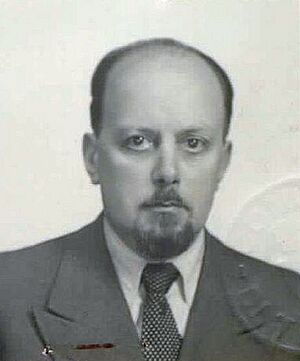Vladimir Bartol facts for kids
Quick facts for kids
Vladimir Bartol
|
|
|---|---|

Bartol in 1953
|
|
| Born | 24 February 1903 Trieste, Austria-Hungary |
| Died | 12 September 1967 (aged 64) Ljubljana, SR Slovenia, SFR Yugoslavia |
| Occupation | Writer |
Vladimir Bartol (born February 24, 1903 – died September 12, 1967) was an important writer. He belonged to the Slovene people living in Italy. Bartol is most famous for his novel Alamut, written in 1938. This book is the most popular Slovene story worldwide and has been translated into many languages.
Contents
About Vladimir Bartol's Life
Vladimir Bartol was born on February 24, 1903. His birthplace was San Giovanni (which is Sveti Ivan in Slovene). This town was a suburb of Trieste, a city that was part of Austria-Hungary at the time. Today, Trieste is in Italy.
His Family and Early Interests
Bartol grew up in a middle-class Slovene family. His father, Gregor Bartol, worked as a post office clerk. His mother, Marica Bartol Nadlišek, was a teacher and a well-known writer. She also supported women's rights.
Vladimir was the third of seven children. His parents made sure he had a great education. His mother taught him about painting. His father shared his love for biology. Vladimir became interested in many subjects. These included philosophy, psychology, and biology. He also loved art, theater, and literature. He wrote about these interests in his short stories.
His Education and Studies
Bartol started school in Trieste. He finished his high school studies in Ljubljana. Then, he went to the University of Ljubljana. There, he studied biology and philosophy.
In Ljubljana, he met a young Slovene philosopher named Klement Jug. Jug introduced him to the ideas of Friedrich Nietzsche. Bartol also paid close attention to the works of Sigmund Freud. Freud was famous for his ideas about the human mind.
Later Life and Career
Vladimir Bartol graduated from university in 1925. He then continued his studies in Paris, France. He studied at the Sorbonne from 1926 to 1927. He received a scholarship to help him with his studies there.
In 1928, he served in the army in Petrovaradin. This place is now in Serbia. From 1933 to 1934, he lived in Belgrade. He worked as an editor for a newspaper called Slovenian Belgrade Weekly.
After that, he returned to Ljubljana. He worked as a writer on his own until 1941. During World War II, he joined the Slovene partisans. These were groups fighting against the occupation. He was an active part of this resistance movement.
After the war, Bartol moved back to his hometown of Trieste. He lived there for ten years, from 1946 to 1956. Later, he was chosen to be a member of the Slovenian Academy of Sciences And Arts. He moved back to Ljubljana. He continued to work for the Academy until he passed away on September 12, 1967. He is buried in the Žale cemetery in Ljubljana.
Vladimir Bartol's Works
Some of Bartol's writings have special meanings. His 1938 novel Alamut is one example. It is seen as a story about the TIGR group. This group fought against Italian rule over the Slovene people in Italy. Alamut takes place in ancient Persia. It tells the story of a group called the Order of Assassins.
List of His Books and Plays
- Lopez (1932, a play)
- Al Araf (1935, a collection of short stories)
- Alamut (1938, a novel). This book has been translated into many languages. These include Czech (1946), Serbian (1954), French (1988), Spanish, and Italian (1989). It was also translated into German (1992), Turkish, Persian (1995), and English (2004). Other translations include Hungarian (2005), Arabic, Greek, and Korean. As of 2003[update] it was also being translated into Hebrew.
- Tržaške humoreske (1957, a collection of funny short stories)
- Čudež na vasi (1984, a novel)
- Don Lorenzo (1985, a story)
- Mladost pri Svetem Ivanu (2001, his autobiography, telling his life story)
See also
 In Spanish: Vladimir Bartol para niños
In Spanish: Vladimir Bartol para niños
- Slovenian literature
- Slovene minority in Italy (1920-1947)
- List of Slovenian writers
- List of Slovenes

